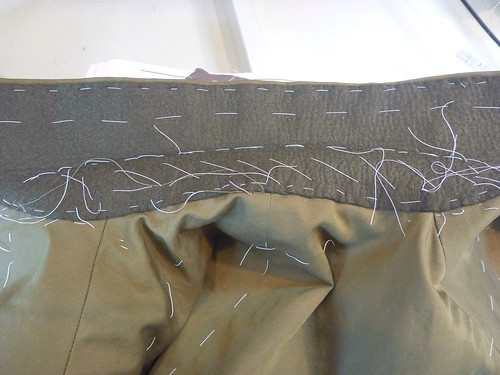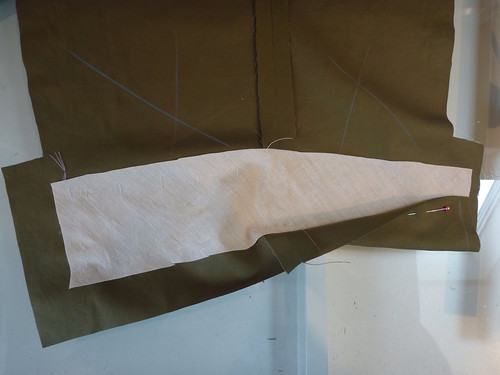All that remains on the jacket are the finishing details, things like sewing on buttons and adding some pick stitched details. These are all little projects that can be done in little snippets of time. If I have a few minutes I can sew on a button or two. But my deadline is looming, so it's time to move ahead on the pants.
I've only made one other pair of pants, so my knowledge of them is pretty shaky. I know that they can be difficult to fit (I struggled a bit with my Jeds), but I've decided going into this project that I'm not going to agonize over them. I don't have either the time or the desire to work through muslin after muslin, looking for that elusive "perfect fit". I'll be more than happy if they fit around my waist and aren't too saggy in the butt.
So, I made a very quick and dirty muslin out of a flimsy Goodwill sheet. It's about as minimal as I could make it. No zipper, no pockets. Just the basic shape sewn onto a waistband of sorts. So here's what I learned about these Bill Blass pants right off the bat. They are very straight legged.
Here I've laid a Jeds leg on top of the white Blass muslin. The Bill Blass pant leg is at least 4" bigger. Palazzo pants? The Jed pant leg is a little too slim for a suit IMO, especially for a guy my age. So I've decided to split the difference and remove 2" of width from the leg.
I also need another inch in the waist to accommodate my little gut. This was actually an easy fix.
Here's where the side seam is hitting the waistband. I added a 1/4" to the seam (sewn in the darker thread), which will give me an extra inch of waist circumference. This adjustment also straightens the hip area, which I'm learning is usually too full on most patterns. I'm just not that curvy in the hip.
The left leg has been tapered, removing 2" of width at the hem. Look how that change has improved the fit at the bottom of the buttocks! I never anticipated this. Fitting Score!
Here the extra fabric in the right pant leg is more evident. It makes the pant visually bottom heavy. Of course,the pattern appears to have been drafted for a 6' 4" man. I've shortened the inseam by 6" and they're still too long!
Are they the perfect fitting pair of pants? Hell no! Will they work? Yes! Time to cut out these bad boys and delve into the mysteries of sewing trousers. Zippers, flys, crotch shields, Oh My! So much new sewing territory.





















